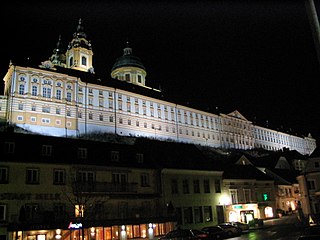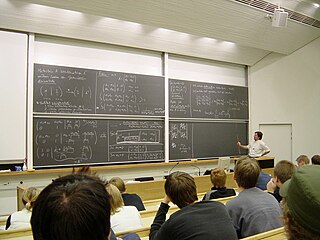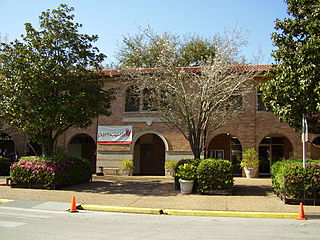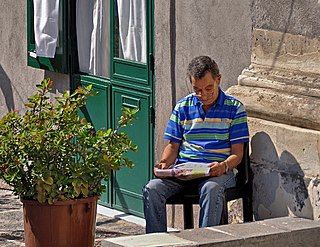Related Research Articles
Whole language is a discredited philosophy of reading, originally developed for teaching literacy in English. It is based on the premise that learning to read English comes naturally to humans, especially young children, in the same way that learning to speak develops naturally. The method became a major model for education in the US, Canada, New Zealand, and Great Britain in the 1980s and 1990s despite there being no scientific support for the method's effectiveness.

Phonics is a method for teaching people how to read and write an alphabetic language. It is done by demonstrating the relationship between the sounds of the spoken language (phonemes), and the letters or groups of letters (graphemes) or syllables of the written language. This is also known as the Alphabetic principle or the Alphabetic code.

A gymnasium is a term in various European languages for a secondary school that prepares students for higher education at a university. It is comparable to the British English terms grammar school or sixth form college, and to US English preparatory high school. Before the 20th century, the gymnasium system was a widespread feature of educational systems throughout many European countries.

In contemporary education, mathematics education is the practice of teaching and learning mathematics, along with the associated scholarly research

In education, a curriculum is broadly defined as the totality of student experiences that occur in the educational process. The term often refers specifically to a planned sequence of instruction, or to a view of the student's experiences in terms of the educator's or school's instructional goals. In a 2003 study, Reys, Reys, Lapan, Holliday, and Wasman refer to curriculum as a set of learning goals articulated across grades that outline the intended mathematics content and process goals at particular points in time throughout the K–12 school program. Curriculum may incorporate the planned interaction of pupils with instructional content, materials, resources, and processes for evaluating the attainment of educational objectives. Curriculum is split into several categories: the explicit, the implicit, the excluded, and the extracurricular.

The Latin school was the grammar school of 14th- to 19th-century Europe, though the latter term was much more common in England. Emphasis was placed, as the name indicates, on learning to use Latin. The education given at Latin schools gave great emphasis to the complicated grammar of the Latin language, initially in its Medieval Latin form. Grammar was the most basic part of the trivium and the Liberal arts — in artistic personifications Grammar's attribute was the birch rod. Latin school prepared students for university, as well as enabling those of middle class status to rise above their station. It was therefore not unusual for children of commoners to attend Latin schools, especially if they were expected to pursue a career within the church. Although Latin schools existed in many parts of Europe in the 14th century and were more open to the laity, prior to that the Church allowed for Latin schools for the sole purpose of training those who would one day become clergymen. Latin schools began to develop to reflect Renaissance humanism around the 1450s. In some countries, but not England, they later lost their popularity as universities and some Catholic orders began to prefer the vernacular.
Khâgne, officially known as classes préparatoires littéraires, is a two-year academic program in the French “post-bac” (≈undergraduate) system, with a specialization in literature and the humanities. It is one of the three main types of Classe préparatoire aux grandes écoles, contrasting with other CPGE majors such as Maths Sup in mathematics and engineering, or Prépa HEC in the business domain.
Oak Hill Academy is a coeducational, nonsectarian private day school located in Lincroft, in Monmouth County, New Jersey, United States, serving students in pre-Kindergarten through eighth grade. Oak Hill Academy was founded in September 1981 by educator Joseph A. Pacelli. The school is academically rigorous and boasts advanced courses in mathematics and Latin. Oak Hill has swimming as a mandatory part of the physical education program.

Synthetic phonics, also known as blended phonics or inductive phonics, is a method of teaching English reading which first teaches the letter sounds and then builds up to blending these sounds together to achieve full pronunciation of whole words.

St. Thomas' Episcopal School (STES) is a private, co-ed Episcopal institution serving pre-kindergarten through 12th grade. It is located in the Meyerland area of Houston, Texas. The school has 553 students and 111 faculty members. It is accredited by the Southwestern Association of Episcopal Schools and is a member of the Houston Association of Independent Schools (HAIS) and the Texas Association of Private and Parochial Schools (TAPPS). Starting in 2020, STES will embark on a $29,000,000 construction project to restore and enhance the school campus. Construction is set to finish in the fall of 2021.
The Academia Británica Cuscatleca (ABC) is an established and highly regarded international bilingual school in El Salvador. It is a community of some 1300 students and is fully accredited by Council of International Schools (CIS), the International Baccalaureate Organisation (IBO), the International Primary Curriculum (IPC) and the Values-Based Trust for Education (VBFT).
The grammar–translation method is a method of teaching foreign languages derived from the classical method of teaching Ancient Greek and Latin. In grammar–translation classes, students learn grammatical rules and then apply those rules by translating sentences between the target language and the native language. Advanced students may be required to translate whole texts word-for-word. The method has two main goals: to enable students to read and translate literature written in the source language, and to further students' general intellectual development. It originated from the practice of teaching Latin; in the early 16th century, students learned Latin for communication, but after the language died out it was studied purely as an academic discipline. When teachers started teaching other foreign languages in the 19th century, they used the same translation-based approach as had been used for teaching Latin. The method has been criticized for its shortcomings.
Education in the Philippines is provided by public and private schools, colleges, universities, and technical and vocational institutions in the country. Funding for public education comes from the national government. For the academic year 2017–2018, about 83% of K–12 students attended public schools and about 17% either attended private schools or were home-schooled.

Reading is the process of taking in the sense or meaning of letters, symbols, etc., especially by sight or touch.

Academy for Character Education (ACE) is a public charter school in Cottage Grove, Oregon, United States.
The Common Core State Standards Initiative is an educational initiative from 2010 that details what K–12 students throughout the United States should know in English language arts and mathematics at the conclusion of each school grade. The initiative is sponsored by the National Governors Association and Council of Chief State School Officers.

The "classical education movement" is a form of education that emphasizes history, literature and language studies within a modern school framework. The term "classical education" has been used in Western culture for several centuries, with each era modifying the definition and adding its own selection of topics. By the end of the 18th century, in addition to the trivium and quadrivium of the Middle Ages, the definition of a classical education embraced study of literature, poetry, drama, philosophy, history, art, and languages.

Mae Carden (1894–1977) was an American educator who developed the Carden Method. She created the code for words, and taking apart sentences and knowing how to put them back together.

Ridgeview Classical Schools, or Ridgeview, is a free public K-12 charter school located at 1800 South Lemay, Fort Collins, Colorado, Larimer County, United States. Ridgeview is chartered through the Poudre School District and serves approximately 750 students, as of 2019. The school is accountable to its charter, the local school district, and the state of Colorado.
Aristoi Classical Academy is a K-12 open-enrollment public charter school based in Katy, Texas. The school opened in 1996 as West Houston Charter School, with an emphasis on fine arts. In 2006, the student population declined with many unfilled seats. After careful deliberation, the school's board of directors voted to transition to a classical school model, an educational option previously available only in area private schools. The school currently has two campuses serving a portion of the Katy Independent School District area.
References
- ↑ "Carden Method Information". Carden Arbor View School. Archived from the original on July 30, 2012. Retrieved July 22, 2010.
- ↑ The Carden Method Pruit, et al.
- ↑ "Carden School of Fresno". Carden School of Fresno. Retrieved July 22, 2010.
- ↑ "Carden Academy of Mission Viejo > Curriculum > Language Arts". Carden Academy of Mission Viejo. Retrieved July 22, 2010.